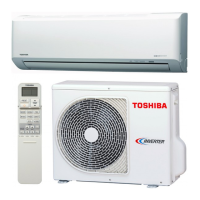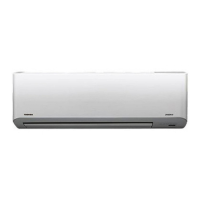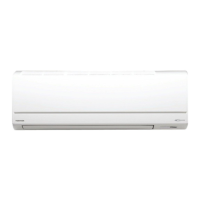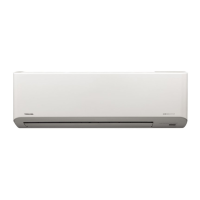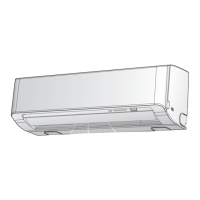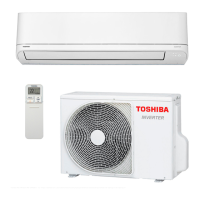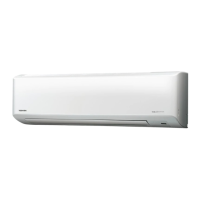
Do you have a question about the Toshiba RAS-10N3AV2-A and is the answer not in the manual?
| Power Supply | 220-240V, 50Hz |
|---|---|
| Refrigerant | R410A |
| Energy Efficiency Ratio (EER) | 3.21 |
| Coefficient of Performance (COP) | 3.61 |
| Outdoor Unit Dimensions (W x H x D) | 660 x 530 x 240 mm |
| Type | Split System |
Crucial safety instructions for installation, operation, and handling refrigerant.
Safety precautions for R410A installation and servicing.
Guidelines for refrigerant piping installation, materials, and joints.
Details on copper pipes, joints, and their specifications.
Procedures and precautions for processing refrigerant piping materials.
Steps and precautions for connecting flare pipes.
Lists tools exclusive for R410A and general tools.
Details on brazing filler materials and the necessity of flux.
Method for brazing to prevent oxidation using nitrogen gas flow.
Exploded views and dimensions for the indoor unit.
Exploded views and dimensions for the outdoor unit.
Specific wiring diagram for 10k and 13k indoor units.
Specific wiring diagram for the 16k indoor unit.
Specifications for electrical components of the indoor unit.
Specifications for electrical components of the outdoor unit.
Refrigerant cycle diagram for specific models.
Refrigerant cycle diagram for specific models.
Refrigerant cycle diagram for specific models.
Control block diagram for the indoor unit and remote controller.
Control block diagram for the outdoor unit.
Overview of the air conditioner's control system.
Roles of indoor/outdoor controllers and inter-unit signals.
Covers basic, cooling/heating, AUTO, and DRY operations.
Covers fan motor, capacity, current, and protective controls.
Details defrost and louver control functions.
Covers ECO, Temporary, and Quiet modes.
Detailed flowcharts for specific operation modes.
Detailed flowcharts for specific operation modes.
Detailed flowcharts for specific operation modes.
Control to prevent cold drafts during heating operation.
Steps to cancel the automatic restart feature.
Behavior during power failure with timer active.
Identifies remote components and explains basic operations.
Detailed remote control operations for various modes.
Automatically restarts the conditioner after a power failure.
Operation for quietness at low fan speed.
Saves energy and controls airflow during sleep.
Visual guides for indoor and outdoor unit installation layout.
Lists optional parts for installation.
Outdoor unit mounting bolt configuration.
Inventory of included accessories and installation components.
Lists essential tools for installation and servicing.
Guidelines for choosing the optimal indoor unit location.
Recommendations for remote control positioning.
Procedures for hole cutting and installation plate mounting.
Guidelines for choosing the optimal outdoor unit location.
Safety guidelines for adding refrigerant.
Procedure for flaring copper pipes for connections.
Steps for properly tightening pipe connections.
Removing air from the system using a vacuum pump.
Guidelines for using a vacuum pump correctly.
Safety measures for handling the inverter unit.
Safety measures for inspecting the outdoor unit's control section.
Confirming the power supply breaker is operating normally.
Confirming the power voltage is within the specified range.
Identifying normal program operations that may seem like issues.
Guide to using the remote for self-diagnosis.
Troubleshooting for indoor unit and remote control problems.
Steps for diagnosing power problems after P.C. board replacement.
Diagnostic steps for a non-operational indoor fan motor.
Troubleshooting for an indoor fan motor that starts automatically.
Detailed steps for diagnosing remote control failures.
Troubleshooting steps when the outdoor unit does not operate due to wiring.
Troubleshooting for outdoor unit stopping after operation starts.
Diagnostic flowchart for the outdoor unit's inverter assembly.
Procedures for checking the indoor unit's P.C. board.
Crucial safety warnings before replacing parts.
Step-by-step guide for replacing indoor unit parts.
Procedures for removing and installing the indoor unit's front panel.
Procedures for replacing the electric parts box.
Procedures for replacing the horizontal louver.
Procedures for replacing the main heat exchanger.
Procedures for replacing the bearing.
Procedures for removing and installing the fan motor.
Instructions for correctly reassembling the cross flow fan.
Procedures for detaching major outdoor unit components.
Procedures for attaching major outdoor unit components.
Procedures for removing and installing the outdoor unit's front cabinet.
Procedures for replacing the inverter assembly with safety precautions.
Procedures for removing and mounting the control board assembly.
Procedures for replacing the side cabinets.
Procedures for replacing the outdoor fan motor.
Procedures for replacing the compressor.
Procedures for replacing the reactors.
Procedures for replacing the expansion valve coil.
Procedures for replacing the fan guard.
Installation procedures for various temperature sensors.
Procedures for replacing temperature sensors for servicing.
Exploded view and list of indoor unit components.
Exploded view and list of indoor unit assemblies.
Exploded view and list of outdoor unit components.
Layout of P.C. boards and sensor characteristic tables.



